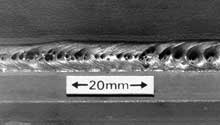Recognizing Porosity in Welding: Exploring Causes, Impacts, and Avoidance Methods
As specialists in the welding sector are well conscious, understanding the reasons, results, and prevention techniques related to porosity is essential for achieving durable and trusted welds. By delving right into the root creates of porosity, analyzing its detrimental results on weld high quality, and checking out reliable avoidance approaches, welders can boost their understanding and skills to generate premium welds consistently.
Common Root Causes Of Porosity
Contamination, in the kind of dirt, grease, or corrosion on the welding surface area, creates gas pockets when heated, leading to porosity in the weld. Incorrect shielding takes place when the protecting gas, generally used in processes like MIG and TIG welding, is not able to totally safeguard the molten weld pool from responding with the surrounding air, resulting in gas entrapment and subsequent porosity. Additionally, inadequate gas protection, often due to inaccurate circulation prices or nozzle positioning, can leave parts of the weld unsafe, permitting porosity to create.
Effects on Weld Top Quality
The existence of porosity in a weld can considerably compromise the overall quality and integrity of the bonded joint. Porosity within a weld creates gaps or cavities that compromise the framework, making it more at risk to breaking, deterioration, and mechanical failing.
In addition, porosity can impede the effectiveness of non-destructive testing (NDT) methods, making it challenging to identify other problems or gaps within the weld. This can lead to substantial safety problems, particularly in essential applications where the architectural integrity of the bonded components is extremely important.

Avoidance Techniques Overview
Provided the damaging influence of porosity on weld high quality, effective avoidance strategies are critical to maintaining the architectural integrity of welded joints. In addition, choosing the proper welding criteria, such as voltage, existing, and travel speed, can assist reduce the threat of porosity development. By including these avoidance techniques into welding practices, the incident of porosity can be considerably decreased, leading to stronger and more reputable bonded joints.
Relevance of Proper Shielding
Proper securing in welding plays a vital role in preventing climatic contamination and making certain the stability of bonded joints. Securing gases, such as argon, helium, or a mix of both, are generally utilized to safeguard the helpful resources weld pool from reacting with aspects airborne like oxygen and nitrogen. When these responsive aspects come into contact with the warm weld swimming pool, they can trigger porosity, causing weak welds with minimized mechanical residential or commercial properties.

Inadequate securing can cause different flaws like porosity, spatter, and oxidation, compromising the architectural integrity of the bonded joint. Adhering to proper protecting methods is important to generate top quality welds with very little defects and make sure the long life and integrity of the bonded parts.
Tracking and Control Methods
Just how can welders effectively keep track of and manage the welding procedure to guarantee ideal outcomes and protect against flaws like porosity? By constantly checking these variables, welders can determine variances from the perfect problems and make immediate adjustments to protect against see here porosity formation.

In addition, executing correct training programs for welders is vital for keeping track of and managing the welding process effectively. What is Porosity. Educating welders on the value of maintaining constant criteria, such as appropriate gas shielding and take a trip rate, can assist avoid porosity issues. Normal analyses and accreditations can also make certain that welders are skilled in tracking and controlling welding procedures
Furthermore, making use of automated welding systems can improve tracking and control abilities. These systems can exactly regulate welding criteria, decreasing the likelihood of human mistake and ensuring read this article regular weld top quality. By integrating innovative monitoring modern technologies, training programs, and automated systems, welders can properly check and control the welding process to minimize porosity problems and attain top notch welds.
Final Thought
